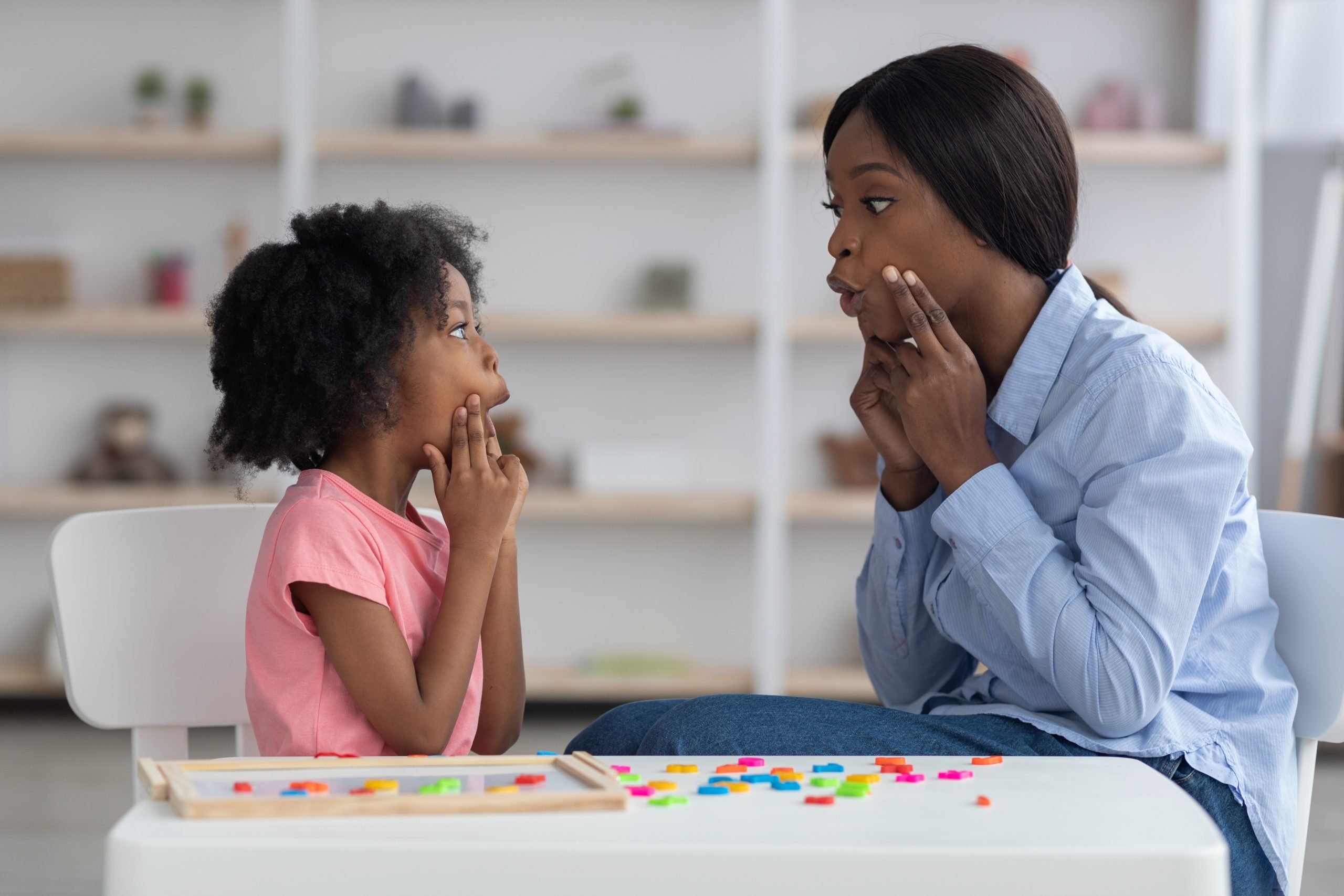Speech-Language Pathology
First appointment
For referrals, see details below.
Send your request
Referrals
A medical referral is required to access Speech-Language Pathology services at the MCH. Please fill out the form below and send it to the Central Intake by:
- Fax: 514-412-4136
- Email: [email protected]
Stuttering/fluency
Our department does not see children who stutter. If stuttering persists for six months or more, please refer directly to your regional “Centre de réadaptation en déficience physique” (CRDP) or CIUSSS.
Services
The Montreal Children’s Hospital Speech-Language Pathology Department consists of a team of bilingual speech-language pathologists with various areas of expertise that offers a wide array of services for children and adolescents who have speech or language difficulties.
The Montreal Children’s Hospital Speech-Language Pathology Department offers pediatric services to children from 0 to 17 years old for:
- Cleft palate and craniofacial differences: assessment and intervention, if necessary, in collaboration with the Cleft and Craniofacial Program.
- Resonance disorders and/or velopharyngeal dysfunction: assessment and intervention which are often part of a specialized clinic.
- Voice disorders: assessment and intervention for various voice problems including nodules, vocal cord paralysis and vocal cord dysfunction.
- Developmental language difficulties and disorders: assessment and intervention or referral for intervention services. See eligibility criteria.
- Neonatology Clinic: assessment and intervention or referral for intervention services.
- Speech-language difficulties associated with an acute traumatic brain injury or a complex medical condition: assessment and intervention, or referral for intervention services. See eligibility criteria.
- Brain, Development and Behaviour clinics: multidisciplinary assessment of children presenting with neurodevelopmental delays.
One of our speech-language pathologists will assess your child to determine speech and language profile, specify the nature of any speech and language difficulties and develop an individualized intervention plan. Once our evaluation is completed, we may either offer services in our department such as diagnostic therapy or redirect children towards community services such as a rehabilitation centre, or their CLSC.
Cree, Inuit and other First Nations
We offer specialized speech-language assessment to Cree, Inuit and other First Nations and share our knowledge in the area of language assessment of bilingual or multilingual children and adolescents. We frequently work with interpreters for families who speak languages other than English and French.
Inpatient services
We work with hospitalized patients with communication difficulties. The speech-language pathologist evaluates the patient’s communication skills and intervenes as necessary during the hospitalization.
Resources
Bilingualism
In Quebec, many families have one parent who speaks French and one parent who speaks English, or a parent who speaks French or English while the other parent speaks another language. Even if English, French, or another language is the only language spoken at home, a child can be exposed to a second language depending on the family’s neighbourhood or the daycare the child attends.
Some parents, caregivers and even teachers might think that exposing a child to several languages at a young age can confuse them and delay their learning of another language. Dr. Fred Genesee, Professor of Psychology at McGill University, has completed research and compiled data on learning two languages from an early age.
- Bilingualism / Multilingualism
- Childhood bilingualism and multilingualism: a short guide for families
- The importance of bilingualism – Video
External resources
- The importance of home language series – Head Start
- Frequently asked questions about French immersion – CRBLM
- Frequently asked questions about the suitability of immersion for all students – CRBLM
- Supporting bilingual children with special education needs – Psychology Today
Cleft palate-craniofacial differences
The speech-language pathologist from the Craniofacial and Cleft Surgery team works with children who have a cleft palate and their families before cleft palate surgery occurs and afterwards. We see the child and the family approximately six months later and continue to follow children up to the age of 18 as needed. We can offer both assessments and intervention for their speech problems related to their repaired cleft palate, sharing ideas about how to stimulate their baby’s early communication.
The speech-language pathologist also works with children with craniofacial differences and their families. These differences can include hemifacial microsomia, Treacher Collins or various syndromes with related craniosynostosis. In general, these children are directed to us by the plastic surgeon, another health professional or a parent, when there is a concern about the child’s speech-language development.
External resources
- Cleft palate – Kids Health
Language development
The prevalence of speech and language disorders has been estimated to be approximately 13 per cent of children between the ages of two and five, with a two to one male to female ratio.
Speech and language disorders can be a child’s only issue, can coexist with another condition for example, attention deficit disorder, or can be part of a broader condition, for example epilepsy, ASD, head injury, etc.
Literacy
Reading to your child can help with both reading development as well as oral language development (that is, vocabulary and grammar).
The Montreal Children’s Hospital is working in partnership with The Centre for Literacy via healthcare providers to promote literacy and engage families in reading.
- Lire/Imagine/Read (LIR)
- Help your child learn language: for children 0-2 years old
- Help your child learn language: for children 2-6 years old
- Help your child love to read: for children 6-9 years old
- Help your child love to read: pre-teens and teens
- Book reading checklist for educators
- Book reading checklist for parents
- Myths and truths pertaining to typically-developing and at-risk children – Video
External resources
Screen time
The Canadian Paediatric Society has recommendations regarding screen time. Please view the following links for more information.
Tracheostomy
A speech-language pathologist may be one the many professionals involved in the care of children having undergone a tracheostomy. These services may include, but are not limited to:
- Language stimulation tips for infants and young children
- In some cases, introduction to alternative modes of communication
- In some cases, a speaking valve trial and related follow-ups
- Language assessment and, in some cases, intervention
- Collaboration with rehabilitation speech-language pathologists working with children who have a tracheostomy
Voice
A speech-language pathologist can evaluate and provide intervention for various voice problems including vocal fold nodules, vocal fold paralysis and paradoxical vocal fold motion (also known as vocal cord dysfunction). In some circumstances, our team is also involved in a multidisciplinary voice clinic in collaboration with otolaryngologists (ENT).
Have you noticed that your child’s voice is sometimes hoarse, unclear or weak? Does your child even “lose” his or her voice on occasion? This voice problem may be explained by the presence of vocal overuse or misuse, including the following:
- Yelling
- Talking loudly
- Excessive talking without taking a break
- Speaking when there is excessive background noise (e.g. talking over the noise of the television or the radio)
- Clearing their throat regularly
- Altering their voice or imitating sounds frequently when playing
- Whispering
- Singing in an abusive fashion (e.g. singing too loudly, too long or altering voice excessively)
For more specific recommendations and questions, talk to your child’s doctor, or speech-language pathologist to get expert advice.
Resonance Disorders/Velopharyngeal Dysfunction
A speech-language pathologist can complete an assessment and intervention as needed for difficulties related to resonance and/or velopharyngeal dysfunction (VPD). VPD occurs when the soft palate and the muscles of the throat do not come together tightly and close as needed when speaking. When this happens, speech can sound hypernasal and air can escape out of the nose at the wrong time when talking. VPD can also affect how children learn speech sounds. VPD can occur in children with repaired cleft palates, submucous cleft palate and with various syndromes. As well, it can happen after an adenoidectomy or in children who have weak throat and/or palate muscles.
Other types of resonance difficulties include hyponasality (the resonance sounds like the nose is always stuffed up) or cul-de-sac (the resonance sounds muffled). These resonance problems can occur in children with large tonsils and/or adenoids or with craniofacial differences.
In many circumstances, the speech-language pathologist will work with the otolaryngologist as part of our specialized clinic called the “Velopharyngeal Dysfunction Clinic”.
To refer for an assessment of velopharyngeal dysfunction or resonance disorder, please email
[email protected]
- Introduction to Nasoendoscopy and Videofluoroscopy – Video
- Velopharyngeal dysfunction – Kids Health
- Velopharyngeal dysfunction – Children’s Hospitals of Philadelphia
For more information on speech and language development and services, parents are invited to consult the following websites:


